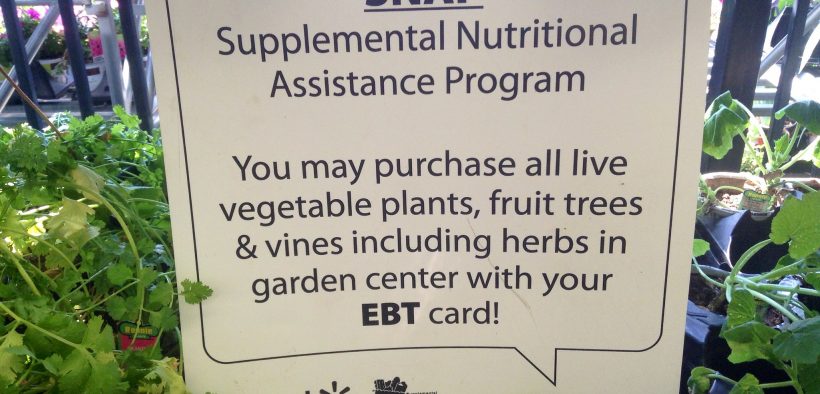3 Million Could Lose Food Stamps Under New Trump Rule

“We particularly worry about food‐insecure households with kids and adolescents.”
The Trump administration is moving to change the way states calculate who is eligible for food stamp assistance through the Supplemental Nutrition Assistance Program, or SNAP, with new requirements the U.S. Department of Agriculture estimates would result in 3 million people losing their benefits.
“This proposal will not only save money, but more importantly it preserves the integrity of the program while ensuring nutrition assistance programs serve those most in need,” said Agriculture Secretary Sonny Perdue in announcing the proposed change on Monday, which his agency claims could save up to $2.5 billion a year.
Perdue’s central argument is that state governments “have misused the flexibility” afforded to them by a “loophole” in the system: beneficiaries of Temporary Assistance to Needy Families program, or TANF, are automatically eligible for food stamp benefits and the free school lunch program in most states. The proposed change would end that automatic qualification, called “categorical eligibility,” and make recipients apply separately for each program.
The average monthly benefit for SNAP recipients is $134.85 per individual or around $1.50 per meal. Around 36 million people currently receive monthly food stamp benefits.
The USDA is taking public comments on the proposed rule change for 60 days before issuing a final regulation.
Creating ‘Benefit Cliffs’
Critics, such as Rebecca Vallas of the Center For American Progress, argue the change would hurt the poor by causing “benefit cliffs,” which cause the sudden loss of benefits if wages go up even slightly past the defined boundary, which is currently set at 130% of the federal poverty limit (around $32,640 for a family of four). Vallas gave an example to illustrate her point:
“Take a worker earning $12.50/hr, with 2 kids. They’re at 125% of the federal poverty level, receiving about $161 in SNAP. Thanks to categorical eligibility, if the worker gets a 50-cent raise (+$86/mo), the family’s SNAP benefits go down by just $31, a net gain to the household of $55.
“But under Trump’s rule, if the same worker gets a 50-cent raise, the whole family loses SNAP overnight, because it puts them >130% FPL. They face a net *loss* of $75 per month. They’re *worse off* after getting a raise.”
Food Insecurity Harms Children
Similarly, Elaine Waxman of the Urban Institute said the change would harm working families with children who are fighting to climb out of poverty: “We particularly worry about food‐insecure households with kids and adolescents. Food insecure children have higher rates of fair and poor health, have higher rates of hospitalization, increased risk of asthma, and delays in cognitive developments.”
According to the Center on Budget and Policy Priorities, 44% of SNAP beneficiaries are children and another 21% are adults who live with children, making two-thirds of food stamp benefits going to families.
The evidence that financial security is linked to child outcomes is clear, with the Center for Disease Control describing strengthened “economic support to families” as one of its foremost strategies in preventing child abuse.
“Many programs that alleviate poverty—either directly, by providing income transfers, or indirectly, by providing food, housing, or medical care—have been shown to improve child well-being,” according to a recent report by the National Academies of Sciences.
Additionally, a 2013 report from the Educational Testing Service estimated the economic and educational cost of child poverty in the U.S. to be $500 billion a year, with the U.S. having the second highest child poverty rate of the world’s 35 richest countries. Critics argue that the new restrictions, which also add higher administrative costs to states, would ultimately cost more to American society than the estimated $2.5 saved by their implementation.
Sen. Debbie Stabenow, the top Democrat on the Senate Agriculture Committee, condemned the change on Tuesday, saying that it would “take food away from families, prevent children from getting school meals, and make it harder for states to administer food assistance.”
Trump Administration and Social Services
Stabenow also argued that the change was an attempt to undermine the authority of congress, as lawmakers rejected the proposal last year: “This proposal is yet another attempt by this administration to circumvent Congress and make harmful changes to nutrition assistance that have been repeatedly rejected on a bipartisan basis.”
The new proposal is not the first time Trump administration has sought to cut social services, with its third budget proposal in March contained hundreds of billions in cuts to federal programs like Medicare, Medicaid, public housing, food stamps, student loan aid, and other non-defense programs. In May, the White House also proposed a change to the way poverty is calculated that experts say would result in slashed benefits for millions of poor Americans.
In addition to the new rule, the Trump administration is also seeking to add work requirements for SNAP eligibility. The White House has encouraged work requirements for Medicaid, as well, with the only state to implement the policy finding thousands of people lost their health insurance without any boost in employment, according to a study by the New England Journal of Medicine.
The Los Angeles Times’ Michael Hiltzik asserts that the Trump administration’s argument that recipients are gaming the system through loopholes is unsupported by evidence:
“According to the Congressional Research Service, about 5.19% of SNAP benefits were overpayments, but only 11% of those overpayments resulted from fraud. That places the fraud rate at about 0.57%,” wrote Hiltzik.
Poverty Prejudice
The New Republic’s Eliot Haspel argues that the Trump administration’s attempts to cut social programs are rooted in an “unyielding and erroneous assumption that people are poor by choice,” even as millions of working Americans remain under the official poverty line.
“In one 1985 survey, repeated in 2016, the percent of respondents saying “welfare benefits make people dependent and encourage them to stay poor” barely budged, going from 59 percent to 54 percent,” wrote Haspel. “This, despite the fact that the overwhelming majority of poor people aren’t able-bodied adults electing not to work, but children, elderly, disabled, or full-time students or caregivers.”
While the Trump administration proposed the new rule as a means to save money, critics challenge its commitment to fiscal responsibility. As Rebecca Vallas points out, the 2017 tax bill gave more in tax breaks to the richest 1 percent than the cost of the entire SNAP program.












Give the mob bread and circus. Translation into American idiom: McDonald’s and football.